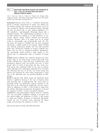Search
for
Sort by
Research
690-720 / 1000+ resultsresearch Glycerol Regulates Stratum Corneum Hydration in Sebaceous Gland Deficient (Asebia) Mice
Glycerol is essential for skin hydration in mice without sebaceous glands.
research Infections, Infestations, and Neoplasms of the Scalp
The chapter explains common scalp conditions, including infections, infestations, and tumors.

research Actinic Keratosis: A Clinical and Epidemiological Review
Actinic keratosis can lead to skin cancer, is more common in fair-skinned people, and can be reduced with sunscreen and treated effectively.
research Erosive Pustular Dermatosis (Chronic Atrophic Dermatosis of the Scalp and Extremities)
Erosive pustular dermatosis is a rare skin disease that's hard to treat and affects the scalp or legs.
research The Spectrum of Cutaneous Manifestations in Lupus Erythematosus: A Comprehensive Review
Recognizing specific skin features helps diagnose and manage lupus erythematosus effectively.

research Identification of Functional Patterns of Androgenetic Alopecia Using Transcriptome Profiling in Distinct Locations of Hair Follicles
AGA linked to inflammation, stress, fibrosis, and disturbed hair follicle stem cells.

research International Society of Hair Restoration Surgery
Various techniques and tools for hair restoration were presented in 1998, including a mathematical model for donor area, use of lasers in surgery, methods for controlling grafted hair direction, and ways to increase graft yield. Satisfaction rates were around 39%, and studies showed trauma and dehydration can damage hair follicles.

research Folliculitis
Folliculitis is an inflammation of hair follicles that requires proper diagnosis and treatment based on the specific cause.

research Pharmacologic Interventions in Aging Hair
Minoxidil and Finasteride are effective for male baldness; more research is needed for hair aging treatments.

research Traction Alopecia in Two Adolescent Sikh Brothers: An Underrecognized Problem Unmasked by Migration
Two Sikh brothers developed permanent hair loss from wearing turbans tightly, a condition that became apparent after they moved to Austria.
research Natural Killer Cells in Atopic and Autoimmune Skin Diseases
NK cells play a role in skin diseases like eczema and psoriasis.

research Regeneration of Hair Follicles Is Modulated by Flightless I (Flii) in a Rodent Vibrissa Model
Flightless I protein affects hair growth, with low levels delaying it and high levels increasing hair length in rodents.

research Tight Junction Barriers in Human Hair Follicles – Role of Claudin-1
Claudin-1 is important for the barrier function and growth of hair.

research Aqueous Extract of Red Deer Antler Promotes Hair Growth by Regulating the Hair Cycle and Cell Proliferation in Hair Follicles
Red deer antler extract helps hair grow by extending the growth phase and increasing cell growth in hair follicles.

research Atypical Fibroxanthoma of the Scalp Following Hair Transplantation in a 35-Year-Old Male
A man developed a rare cancer on his scalp after a hair transplant possibly due to sun damage, laser effects, and inflammation.

research The Hair Follicle as a Dynamic Mini-Organ
Hair follicles are complex, dynamic mini-organs that help us understand cell growth, death, migration, and differentiation, as well as tissue regeneration and tumor biology.

research The Hair Follicle as an Estrogen Target and Source
Estrogens significantly influence hair growth by interacting with receptors in hair follicles and may help regulate the hair growth cycle.

research Androgen Receptors Are Only Present in Mesenchyme-Derived Dermal Papilla Cells of Red Deer Neck Follicles When Raised Androgens Induce a Mane in the Breeding Season
Red deer only have androgen receptors in neck hair cells for mane growth during breeding season.

research Understanding the Functional Contribution of Dermal Stem Cells to Hair Follicle Regeneration and Skin Wound Healing
Dermal stem cells help regenerate hair follicles and heal skin wounds.

research Autoantigen Discovery in the Hair Loss Disorder, Alopecia Areata: Implications of Post-Translational Modifications
New protein changes may be involved in the immune attack on hair follicles in alopecia areata.

research Molecular Mechanisms of Androgenetic Alopecia
AGA causes hair loss by shrinking hair follicles due to DHT binding, and can be treated with finasteride and minoxidil.

research Braicitinib Treatment Reduced the Expansion of CD8+ T Cells in C3H Mice With Skin Grafts-Induced Alopecia Areata
Baricitinib treatment helped reduce hair loss symptoms in mice by decreasing inflammation-related immune cells.

research Fibrosing Alopecia in a Pattern Distribution
Fibrosing alopecia in a pattern distribution is a unique hair loss condition with inflammation and scarring, resembling but distinct from common balding.

research Embryonic-Like Regenerative Phenomenon: Wound-Induced Hair Follicle Neogenesis
New hair can grow from large wounds in mice, but less so as they age, involving reprogramming of skin cells and specific molecular pathways.

research Rethinking Regeneration: Empowerment of Stem Cells by Inflammation
Inflammation helps stem cells repair tissue by directing their behavior.

research Androgens and Hair: A Biological Paradox with Clinical Consequences
Androgens can both increase body hair and cause scalp hair loss.

research Laser for Hair Removal: A Review of Technologies and Efficacy
Lasers are FDA-approved for permanent hair reduction, not removal, and more research is needed to improve treatments.

research Hair Loss in Elderly Women: A Dermatological Concern
Hair loss in elderly women is often caused by various factors, including hormonal changes after menopause.

research Hair Aging And Anti-Aging
Hair ages due to various factors and treatments like minoxidil and finasteride can help, but more research and better public awareness are needed.